A new species of pterosaur with an unusual snout has been described from Germany.
The ancient flying reptile would have used its toothed snout with a flared end to filter-feed on tiny crustaceans in shallow tropical seas.
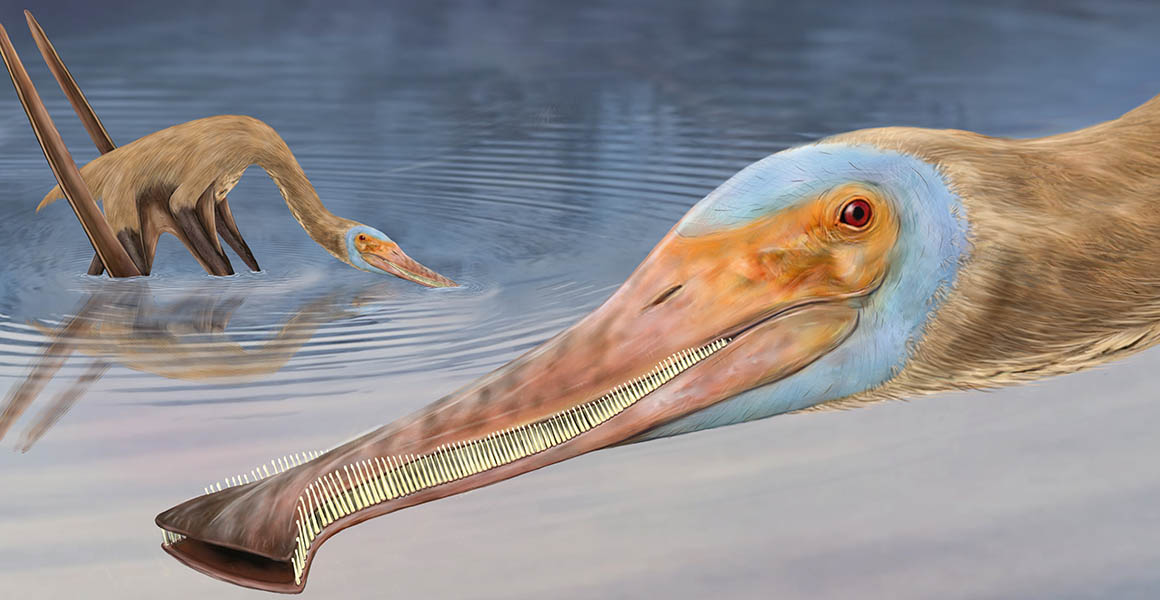
The new species of pterosaur had a really unusual upturned snout, with numerous hooked teeth and and open, flared end ©Megan Jacobs
A new species of pterosaur with an unusual snout has been described from Germany.
The ancient flying reptile would have used its toothed snout with a flared end to filter-feed on tiny crustaceans in shallow tropical seas.
Around 150 million years ago, a curious type of pterosaur would have been dabbling in the seas of Europe.
With an extraordinary, flared tip, hundreds of blunt teeth and an upturned snout, scientists believe that Balaenognathus maeuseri would have scooped plankton-laden water into its mouth, filtered the tiny animals out, before swallowing the food in way similar to modern flamingos.
Professor David Martill, from the University of Portsmouth and lead author of the paper describing the new species, says, 'The jaws of this pterosaur are really long and lined with small fine, hooked teeth, with tiny spaces between them like a nit comb.
'The long jaw is curved upwards like an avocet and at the end it flares out like a spoonbill. There are no teeth at the end of its mouth, but there are teeth all the way along both jaws right to the back of its smile.'
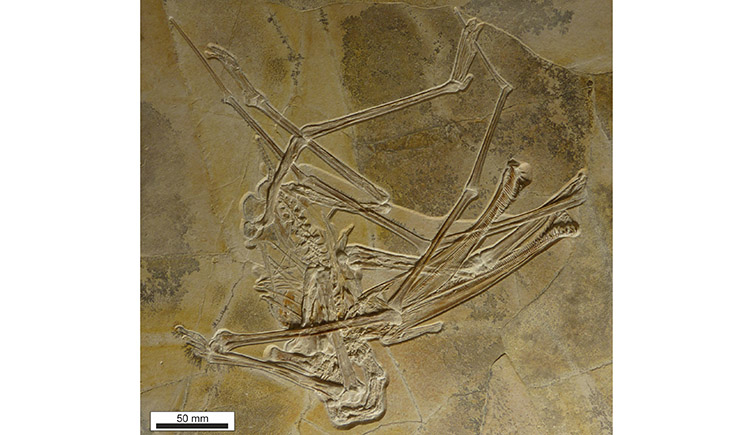
The fossil shows remarkable levels of preservation, with the animal still full articulated and even soft tissue ©PalZ
'What's even more remarkable,' says David, 'is some of the teeth have a hook on the end, which we've never seen before in a pterosaur ever. These small hooks would have been used to catch the tiny shrimp the pterosaur likely fed on – making sure they went down its throat and weren't squeezed between the teeth.'
The pterosaur has recently been described in the journal Paläontologische Zeitschrift.
Travel back to the Late Jurassic, and Europe would have looked completely different.
Rather than one single massive landmass, the continent would have been an archipelago of subtropical islands scatted across a warm shallow sea. Between these islands would have been countless smaller sandy spits and outcrops rising from the waters.
These islands were inhabited by a whole range of creatures, including crustaceans, large fish and rays swimming in the surf, turtles hauling themselves onto the beaches to nest, and marine crocodiles basking in the sun.
Whirling and chattering through the skies were dozens of species of pterosaurs, feeding on the abundant marine life before returning to the islands to breed not unlike like modern seabirds do today.
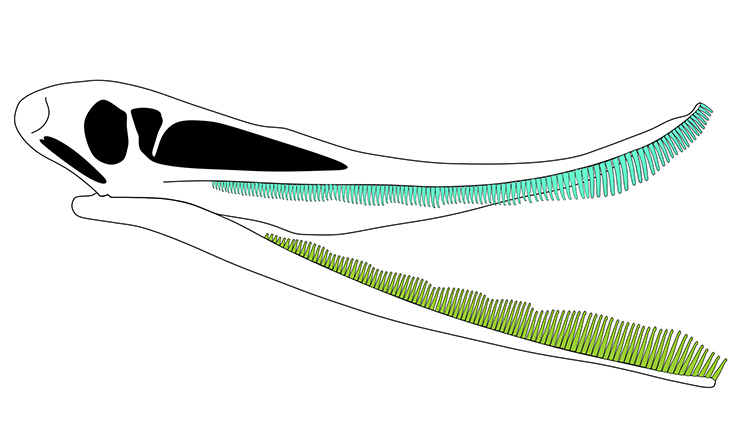
The skull shows anumber of adaptations to filter-feeding, leading scientists to name the new species 'whale-mouth' ©PalZ
But one of these pterosaurs was not filling itself on a diet of fish or squid.
The fossil of a highly unusual flying reptile was unearthed by accident in the quarries of the Franconian Jura in Bavaria, Germany, when a block of stone containing the remains of a crocodile-like animal was removed.
Along with it, they found the beautifully preserved skeleton of a pterosaur, still fully articulated and even showing some soft tissue remains.
'This was a rather serendipitous find of a well-preserved skeleton with near perfect articulation, which suggests the carcass must have been at a very early stage of decay with all joints, including their ligaments, still viable,' explains David. 'It must have been buried in sediment almost as soon as it had died.'
Despite only being about a metre long, the fossil has several adaptations that the scientists believe point to a life of dabbling for food.
The most obvious are those of the skull, which show a number of key modifications such as the 480 fine teeth with hooks, open ended snout to allow for a continuous stream of water to enter the mouth, and highly developed palate that may have helped direct the water out again.
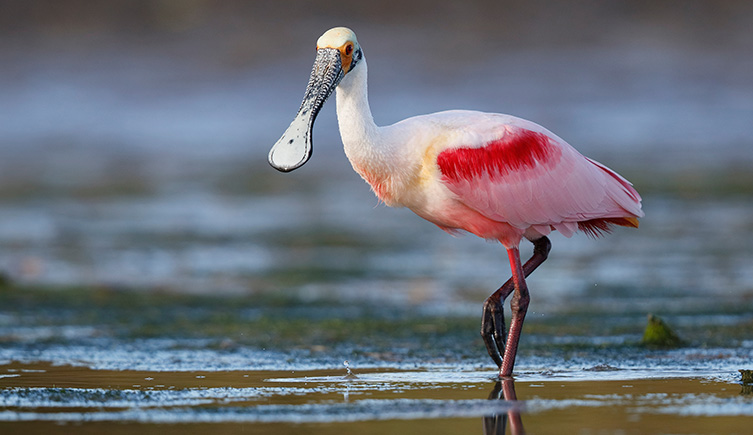
The snout of the new pterosaur looks superficially similar to that of modern-day spoonbills, and so may have been used for a similar purpose © Brian Lasenby/Shutterstock
But the specimen also shows that the pterosaur had especially long limbs, which would have been an advantage if it were spending its days wading around the shallow seas in which it would have lived and fed.
As such, the researchers actually named the animal Balaenognathus, which roughly translates as 'whale-mouth', in honour of its assumed lifestyle.
While this is not the only pterosaur thought to have been adapted for this behaviour, the new find adds to our understand of the flying reptiles in this region at this time, helping to flesh out a picture of this thriving coastal ecosystem.
While Balaenognathus was paddling around the sandy shallows, other species would have been wheeling through the tropical skies on the look-out for fish, while smaller species may have been crunching on the molluscs that would have been growing along the coast.
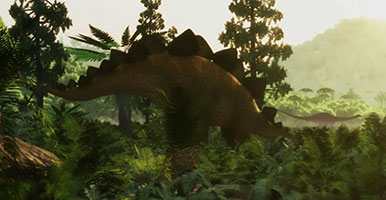
Find out what Museum scientists are revealing about how dinosaurs looked, lived and behaved.
Don't miss a thing
Receive email updates about our news, science, exhibitions, events, products, services and fundraising activities. We may occasionally include third-party content from our corporate partners and other museums. We will not share your personal details with these third parties. You must be over the age of 13. Privacy notice.
Follow us on social media